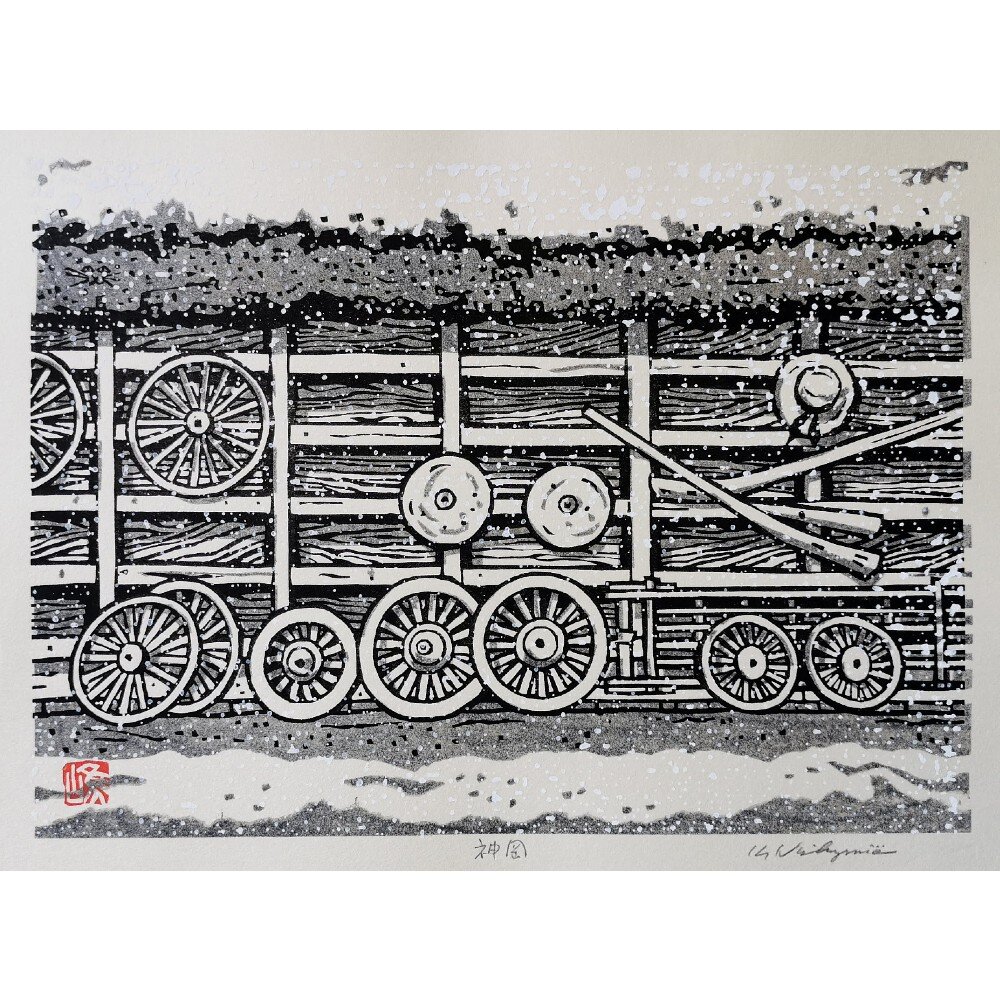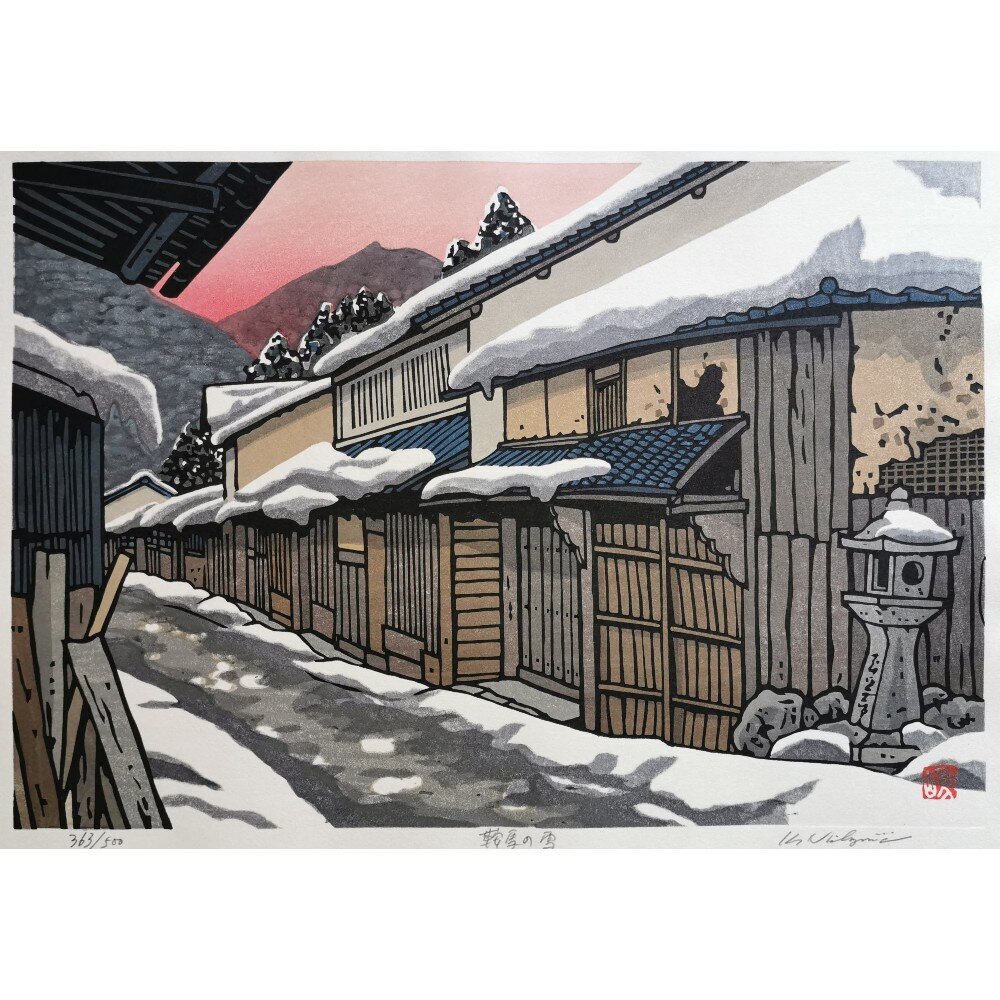西嶋勝之 KATSUYUKI NISHIJIMA (1945-PRESENT)
Katsuyuki Nishijima’s printmaking honours the rich spiritual and cultural history of Japan. Referencing an evolution of 19th & 20th Century printing principles throughout ukiyo-e, shin-hanga, & sosaku hanga in his approach, Nishijima fabulously distils a vision of traditional Japan - rural, minka (民家) scenes: provincial farmhouses, old storefronts, quaint village streets - in a manner which subtly balances an intimacy & spirituality in his pieces without any over-elaboration or distraction to detail.
Devoid of any depiction of human life, or any indication toward modern society, Nishijima’s approach focuses on capturing a pure, timeless image of Japan. Continuing to publish new editions with a wide & affordable accessibility to his works after nearly half a century of printmaking, Nishijima offers a selfless & sensitive reminder of Japan’s cultural past - a depth & dimension to his printmaking often less voiced.
Artist Biography:
ROOTS IN 20TH CENTURY PRINTMAKING.
Born in Yamaguchi prefecture, 1945, Katsuyuki Nishijima’s work echoes the charming and romanticised imagery reminiscent of the shin-hanga movement of the early 20th Century. Parallelling the domestically successful depiction of bijin, landscape, & kabuki themes of ukiyo-e, shin-hanga brought a new dimensionality & sensitivity to Japanese printmaking. Amidst an era of developing Westernisation, artists such as 川瀬巴水 Kawase Hasui (1883-1957), 土屋光逸 Tsuchiya Koitsu (1870-1949) and 吉田博 Hiroshi Yoshida (1876-1950) drew from European Impressionism to inspire a new dimensionality & manipulation toward the use of light & colour in their prints. Embodying a new style of print, shin-hanga served to unite traditional ukiyo-e themes to modern Western art culture; introduce an added intimacy and expression of ambience; and capture a nostalgic air of sentimentality amidst a threatening cultural shift.
THE WORKS OF KATSUYUKI NISHIJIMA.
Nishijima’s prints of traditional Japan echo the same rich romanticism of shin-hanga. However, despite featuring a union of thematic, technical, & printmaking principles drawn from both ukiyo-e & shin-hanga, Nishijima’s typical Kyoto, minka scenes, of provincial townhouses, quaint farmhouses, & machiya storefronts, capture a differing, distilled vision of Japan. Devoid of any depiction of human life comparable to that of a lively Yoshida print; any juxtaposition of modern building, bridge, street light, or telegraph pole to allude toward a modernising society typical of a Shiro Kasamatsu (1898-1991) piece; nor the presence of intense & emotive midnight hues representative of a Koitsu moonlit scene - Nishijima’s compositions are somewhat timeless, embody warm colour tones, and faithfully distil the character and spirit of traditional Japan without any over-elaboration or distraction to detail.
Reminding us of the calmer, spiritual, and cultural past of Japan - a contrasting relief to its modern & fast-moving metropolitan image today, Nishijima has produced an immense body of work since his initial apprenticeship under the Mikumo publishing house (1964-1968), and his early experimentation with stencils. Whilst limited written information exists to concisely document both Nishijima’s life or formal catalogue of works; following his independent & joint exhibitions with the Kyoto Independent Group of the late 1960’s, Nishijima has dedicated nearly half a century to the craft of Japanese printmaking since his earliest woodblocks of the mid 1970’s.
Celebrated for offering a wide & affordable accessibility to his work (an approach which mirrors ukiyo-e - prints for the people: readily accessible & relatively inexpensive), Nishijima’s core work can typically be classified across a common range of series, image sizes & open/unlimited, or large edition runs:
Series: 木曾街道 Kisokaido. (Sheet size: Double Oban (approx: 38cm x 51cm)).
木曾街道 Kisokaido is Nishijima’s contemporary homage to the legendary ukiyo-e series: The Sixty-nine Stations of the Kisokaido by Utagawa Hiroshige (1797-1858) & Keisai Eisen (1790-1848), circa 1834-1842. It is not clear whether Nishijima produced a counterpart design for each of the original sixty-nine post stations between Edo (Tokyo) & Kyoto, however the series showcases Nishijima’s most striking use & contrast of bold colour, imposing foreground imagery, and portrayal of light/seasonality/weather. Nishijima’s red shima seal and 木曾街道 title to plate. Edition /500.
Series: 新近江八景 New Eight Views of Ōmi. (Sheet size: Double Oban (approx: 38cm x 51cm)).
新近江八景 New Eight Views of Ōmi details Nishijima’s contemporary take on The Eight Views of Omi - a series evolving from Chinese Song (960-1279) & Yuan (1271-1368) dynasty where tradition often sought poetic & painted works to be depicted across a series of eight specific themes: Evening Snow; Evening Rain; Returning Boats; Geese flying home; Clear weather; Autumn Moon; Evening (Vesper) Bell; & Evening Sunset.
Prince Konoe Masaie (1444-1505) & his son Konoe Naomichi (d.1544) parodied (/mitate-e’d) this tradition upon a visit to Sasaki Takayori (d.1520), the former constable daimyo of Omi province, circa 1500. Composing eight verses of poetry, each verse echoed the beauty around Lake Biwa under various lights of the eight traditional themes. (for example: Evening Snow at Hira & Evening Rain at Karasaki). Eight Views of Ōmi (or otherwise known Eight Views of Lake Biwa) soon evolved to become a particularly popular & reimagined theme/subject throughout ukiyo-e.
Nishijima’s red shima seal and 新近江八景 title to plate. Edition /500.
Size: Mini: (Image approx 11cm x 16cm). Unlimited Editions.
Size Small: Chuban (Image approx: 20cm x 27cm)). Unlimited Editions.
Size: Medium: Oban (Image approx: 38cm x 25cm) & Large Oban (Image approx: 47cm x 30cm). Typical editions of /100 /500.
Size: Large: Double Oban (Image approx: 54cm x 40cm). Typical editions of /100 /500.
Size: Extra Large: Rare, likely early works.
Monochrome Editions: Katsuyuki Nishijima’s most recent theme of work. Black & white/monochrome editions to include entirely new designs, and possibly monochrome prints of old key block designs (?). Published 2018 onward.
A SELFLESS, SENSITIVE & UNDERSTATED MASTER.
Whilst Katsuyuki Nishijima’s work is hugely successful and sees consistently strong international demand, he perhaps yet remains one of the most relatively understated contemporary Japanese artists today. A commanding printer in his own right: achieving consistent, subtle gradations of colour across large printing runs - an immensely skilled feat of craftsmanship in itself -, there remains a depth & selflessness to his printmaking which is often less voiced.
Katsuyuki Nishijima honours the spirit of tradition and his knowledge of ukiyo-e & his craft is vast. Referencing the evolution of 19th & 20th Century printmaking principles throughout ukiyo-e, shin-hanga, & sosaku hanga, Nishijima pays tribute to Japan’s spiritual & cultural history - famed stories/themes from its past which are either subtly woven through the historical significance of his chosen scenes, or distinctly reimagined in his titled, seriesed work. Developing an artistry which ultimately finely balances a need for evoking a necessary intimacy whilst maintaining a clarity and uncluttered sense of detail in his compositions, Nishijima feels no obligation to explain, seize the limelight, or headline the intention of his compositions - sensitively and selflessly allowing for the exploration of the one’s own personal explanation to the scene & connection to Japan.
Written by: Jack Payne | © Lambsquay Gallery
Bibliography/Articles:
Japan Minka Revival Association 認定NPO法人 日本民家再生協会 ニホンミンカサイセイキョウカイ. [Online]. Japan Minka Revival Association. Available from: http://minka.jp [Accessed: 1 June 2020].
King, J. (2010) Beyond The Great Wave: the Japanese landscape print 1727-1960. Bern, Peter Lang.
Merritt, H. & Yamada, N. (1999) Guide to modern Japanese woodblock prints: 1900-1975. Honolulu, Univ. of Hawaii Press.














































